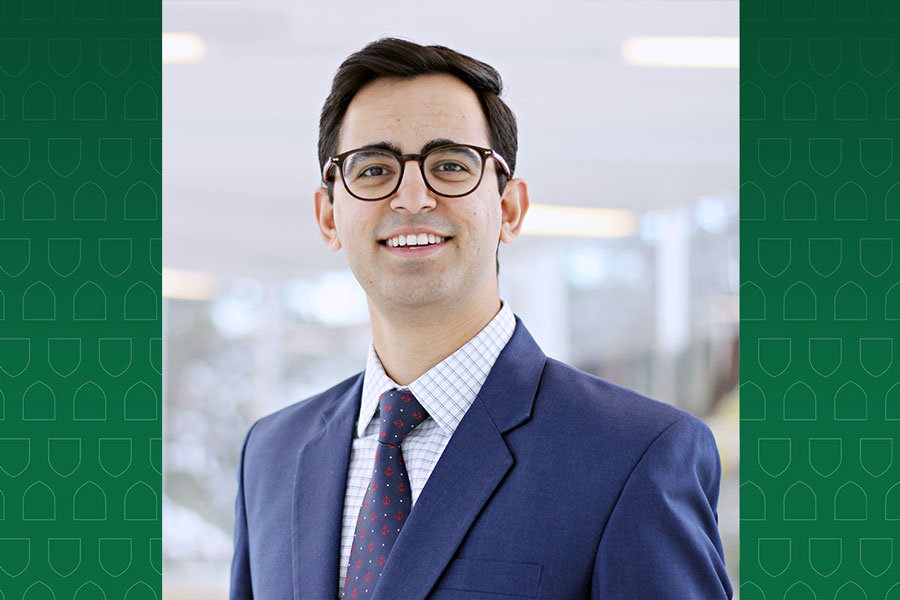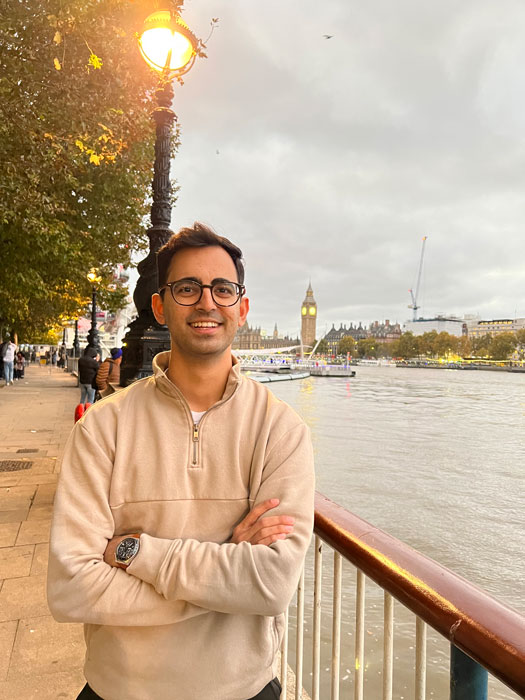
‘It really feels like a big family’
Dr. Simranjeet (Sim) Singh (BSc’18, MD’22) found a sense of community at the University of Saskatchewan
By SHANNON BOKLASCHUKFor University of Saskatchewan (USask) graduate Dr. Simranjeet (Sim) Singh (BSc’18, MD’22), the best part of studying in USask’s College of Medicine can be summarized in one word: community.
“While not a small program, the cohesiveness among students and the vested interest that teachers took in your education made me feel well supported,” said the 27-year-old Singh, who is now in Ottawa for a five-year specialty training residency in emergency medicine. “You were encouraged to make mistakes and feel vulnerable but were also extremely well supported.”
Finding community was important to Singh after an early life on the move. Born in Delhi, India, Singh grew up in the United Arab Emirates before moving to Canada at the age of 15. When he relocated to Saskatoon, he felt welcomed into the community and at Bedford Road Collegiate, where his teachers were invested in his success.

As a high school student, Singh graduated from a rigorous International Baccalaureate (IB) program, served as a tutor, coached soccer at a homeless shelter, and founded the only high-school cricket club in the city, which helped to earn him a prestigious Schulich Leader Scholarship in 2015 valued at $60,000.
A sense of community remained once Singh came to USask as a College of Arts and Science student. One professor in particular, Dr. Scott Napper (BSc’94, PhD’99), made an impression because of the dedication that he showed to each student.
“You would think he would have no time whatsoever for a one-on-one chat, but when I went to discuss the results of a mid-term mark, he was more than happy to visit,” said Singh.
“He sat me down; he listened to me. He didn’t just talk to me about the exam, but he also talked to me about my aspirations. As an 18-year-old who wanted to do medicine, but also lacked in confidence, I actually remember him being one of the first people to tell me, ‘You will get into medicine.’ ”
Singh went on to earn a Bachelor of Science degree in physiology and pharmacology in the College of Arts and Science in 2018 before beginning his studies in the College of Medicine. As a student in the medical doctor (MD) program, he continued to feel welcomed and supported at USask.
“You now have physicians who are also educators who take a vested interest in you and further provide you with that sense of community, give you time, give you respect,” he said. “I keep using this term ‘community,’ but it really feels like a big family.”
As an MD student, Singh received an award for research excellence in the College in Medicine before completing his degree in 2022. Currently, he is nearing the end of his second year of a five-year residency training program at The Ottawa Hospital in Ottawa, Ont.
“I really think I am the byproduct of some great mentors I have had in my life and people who have really shaped the person I am today,” he said. “I have seen firsthand what great teaching and great education (is), and the effect it had on me at the University of Saskatchewan, and I’m hoping I can do this with more students in the future.”
The Green&White asked Dr. Sim Singh about his time at USask, what inspired him to focus on emergency medicine, and his advice for other students who may want to follow in his footsteps.
Why did you want to study medicine?
My first recollection of learning physiology was (in) Grade 8. The human body seemed like an intricate machine that, while admirable to observe, seemed too complex to truly understand. My undergraduate degree in physiology and pharmacology at USask converted the skepticism into an eagerness to explore further. The opportunity to fuel curiosity while serving injured or vulnerable physiologies was exciting enough to explore the medical field.
What is your fondest memory of being a student at USask?
Exam time turned the USask campus into a multiverse: Class at 8 am, walk around the Bowl at lunch, socialize while playing a few games of squash at the PAC before library hopping from Murray to Law to Edwards with friends until midnight—only to do it all over the next day.
You are now in Ottawa for a five-year residency in emergency medicine. What has the experience been like so far?
Challenging but rewarding. Leaving friends and family is never easy, but living in the capital has opened my eyes to many novel experiences—meeting new people, exploring different cuisines, and getting stuck in traffic regularly (not something I had experienced a lot in Saskatoon!).
Why did you want to focus on emergency medicine? What inspired you to pursue this area?
Emergency medicine (EM) is attractive for its wide breath of expertise, acuity, and team-based approach. As EM physicians, we treat patient concerns from head to toe in demographics ranging from newborns to the geriatric population. You can see a broken pinky finger in Room 1 and follow that up with a heart attack in the next room (ideally seeing that before the broken finger, though!). This is layered with the ever-growing complexities of health care—long wait times, bed shortages, lack of primary care providers and follow up. As frontline workers, it also offers exciting opportunities to be involved in policy work and health-care advocacy aimed at upstream changes.
The EM group in Saskatchewan and within Canada has been pivotal in my decision to pursue this career. My first shift in the (emergency department) was exciting but clearly demonstrated several knowledge gaps. Fast forward a couple of years: I received a reference letter from the same staff I had worked with previously. The community fosters a healthy learning environment with an emphasis on the growth mindset whilst also maintaining work-life balance that is imperative for the effective functioning of an EM physician.
What do you enjoy about this work?
The responsibility of taking care of severely sick patients propels a cycle of continuous self-development in order to provide safe and evidence-based care. The science, however, is not enough. Fostering a therapeutic alliance with patients is vital not just to treat but also to prevent disease. This is perhaps where I derive the greatest joy in this work.
Two patients may have similar chief concerns of chest pain—but behind those are different emotions, expectations, concerns, and impacts on quality of life. The science between a few patients may be similar, but the approach usually isn’t.
What is your advice to other USask prospective and current students who may wish to study medicine and become a physician?
Unfortunately, I am yet to come across a “blueprint to medicine.” Academic prowess is often highlighted to be vital to study medicine, but it does not necessarily have to come from science backgrounds. Your work ethic can be demonstrated by any undergraduate program. Medicine is information overload, and being able to manage that is key.
Medical schools and residency programs are increasingly more interested in extra-curricular activities as it tends to give more information about an individual than a mere grade: What are your hobbies? Have you demonstrated leadership skills? How do you handle success/failure?
Lastly, find a way to be involved in the health-care system (as difficult as it can be!). Volunteer, scribe, or simply observe any health-care worker that will let you in order to get a sense of the functioning of the health-care system.
--with files from John Grainger


